
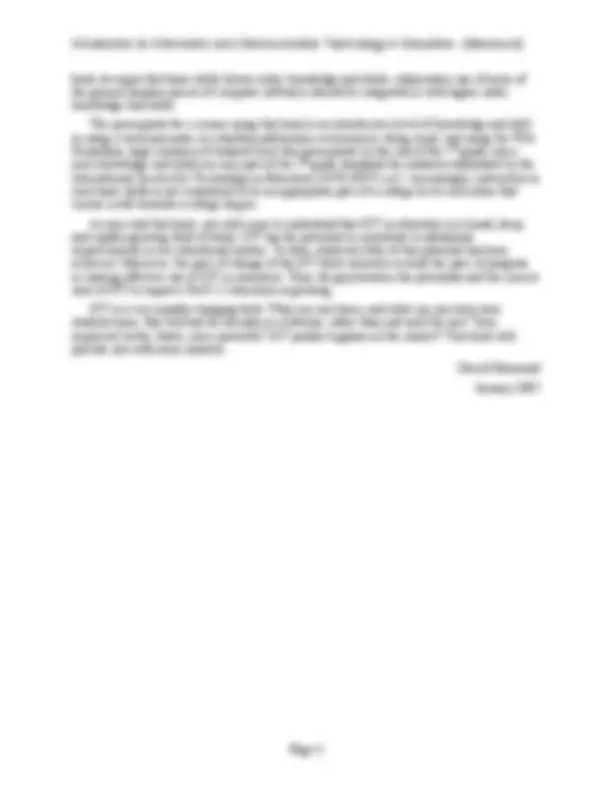



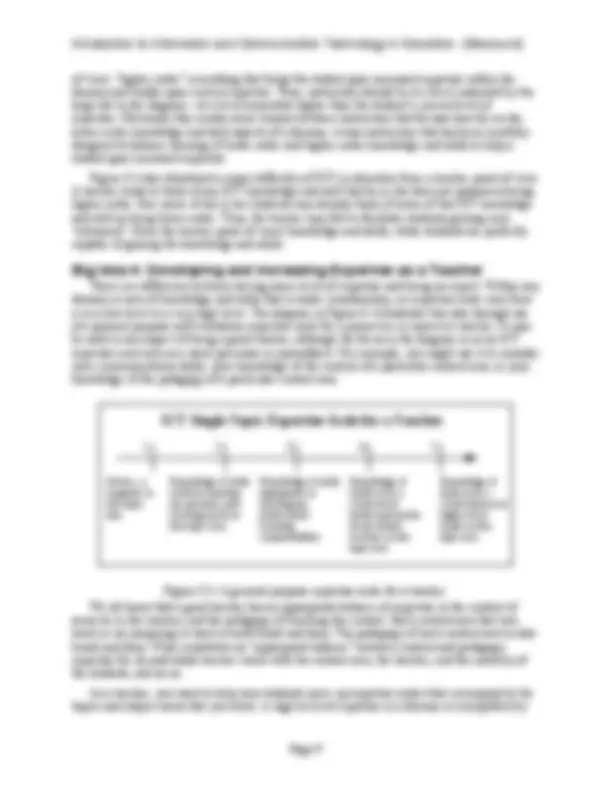











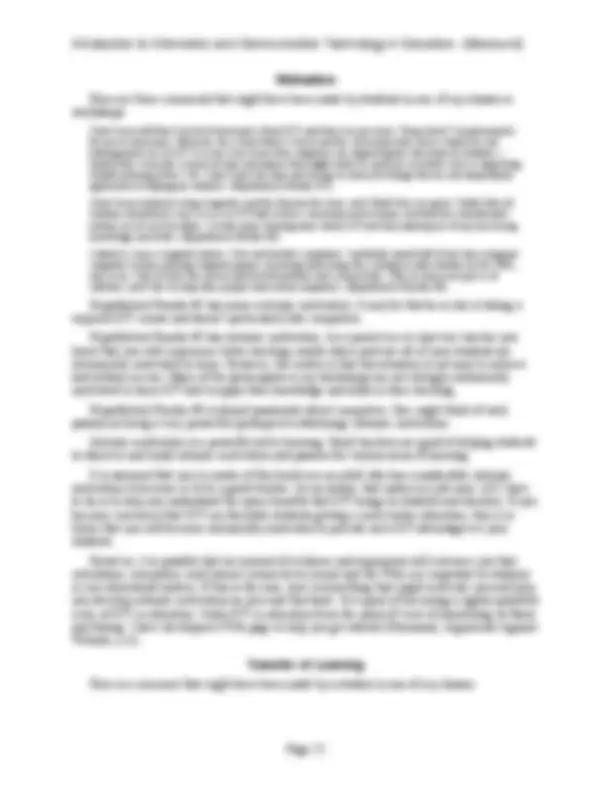







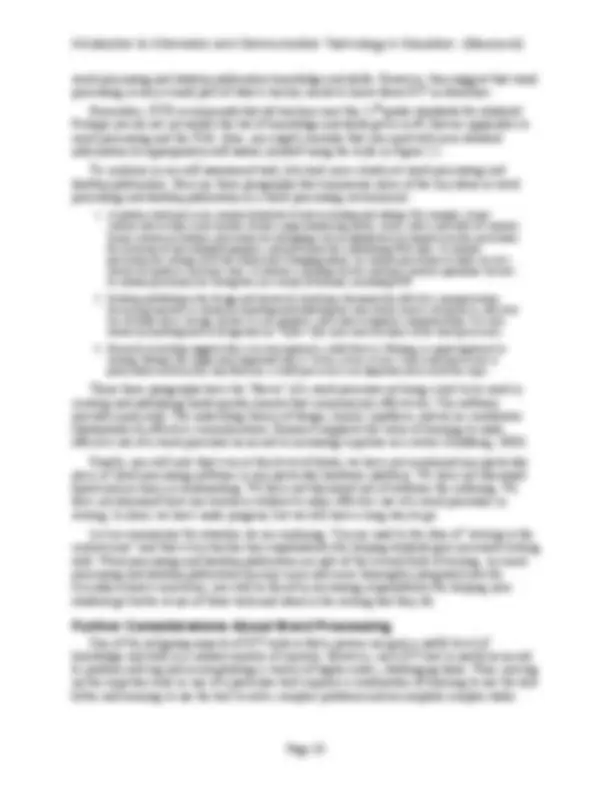

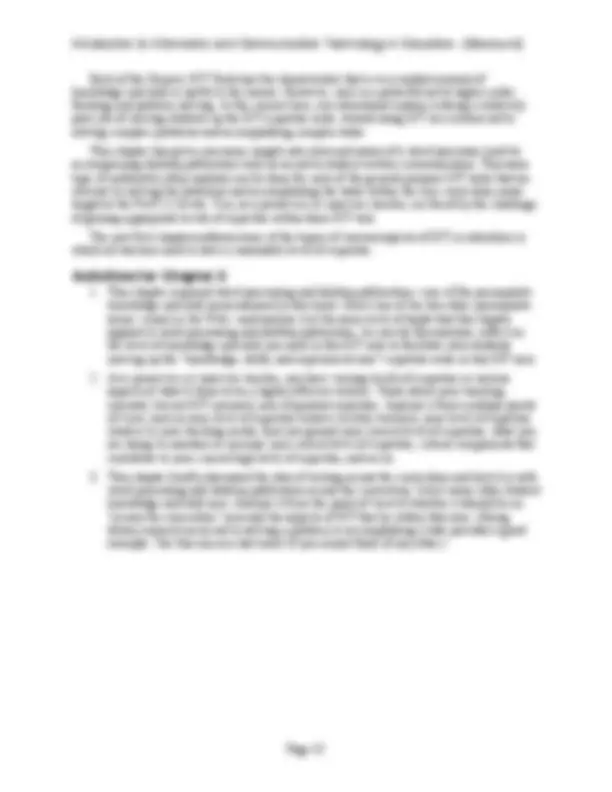


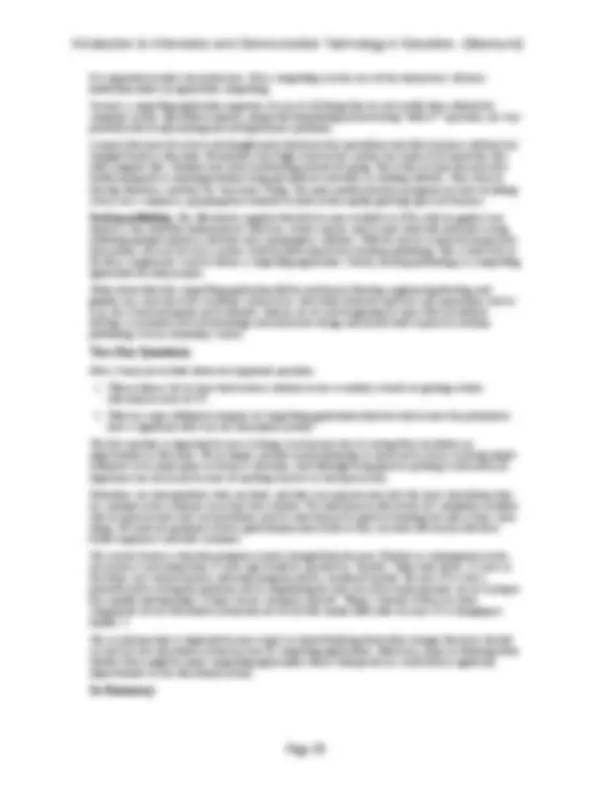
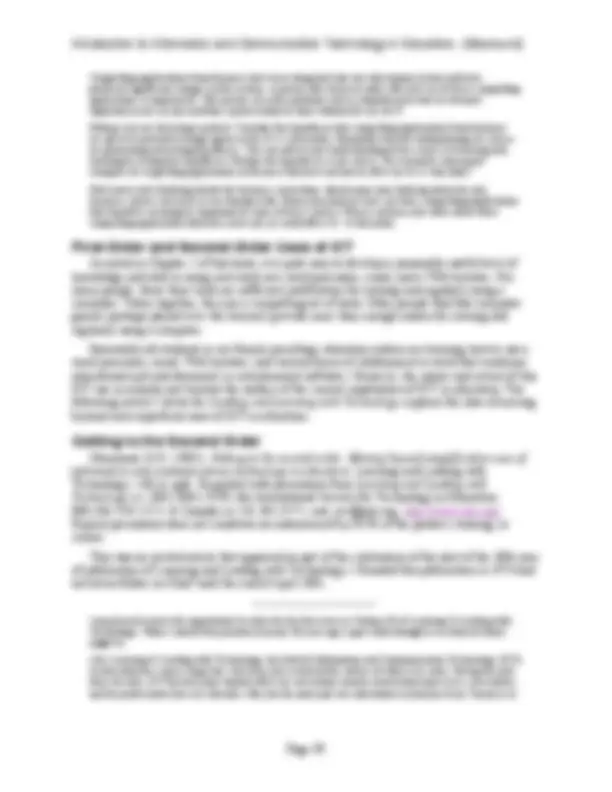


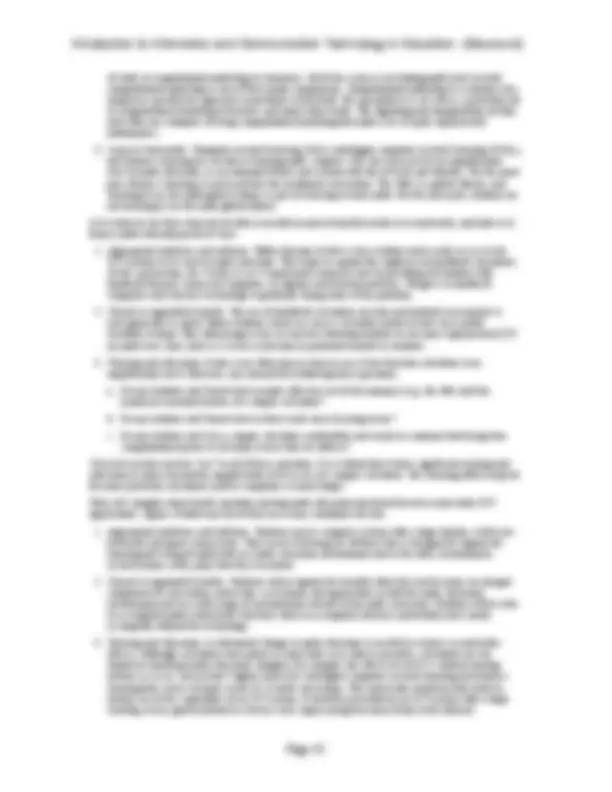


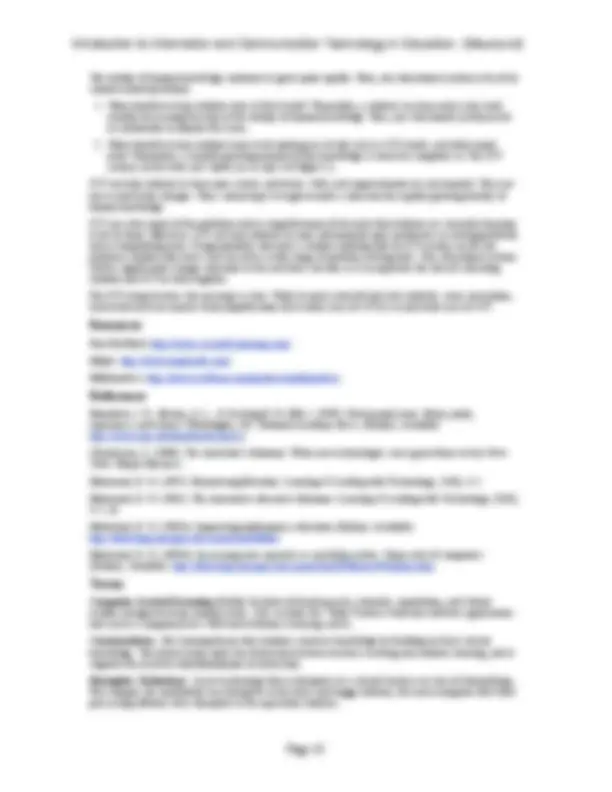




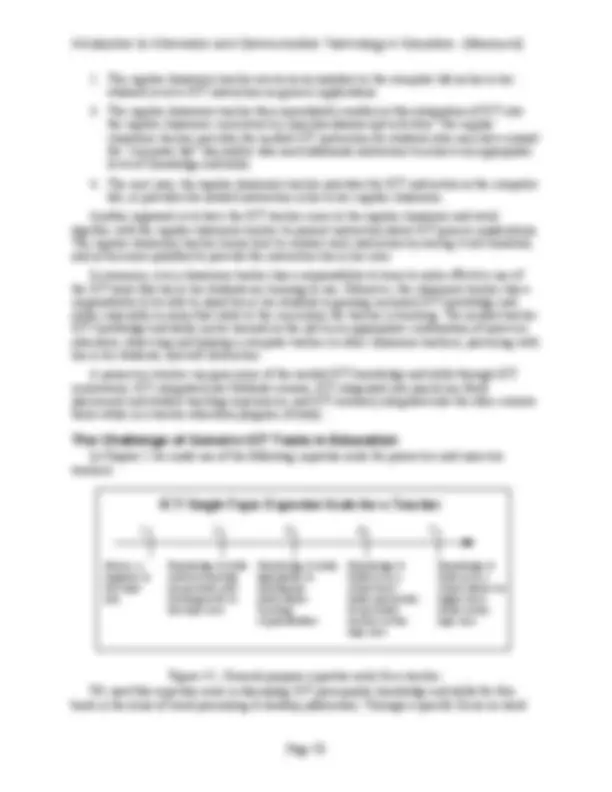



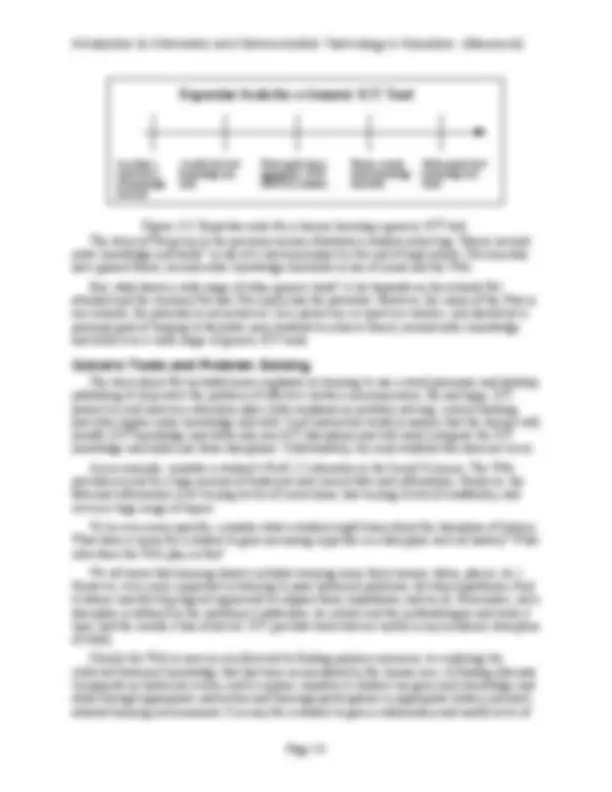





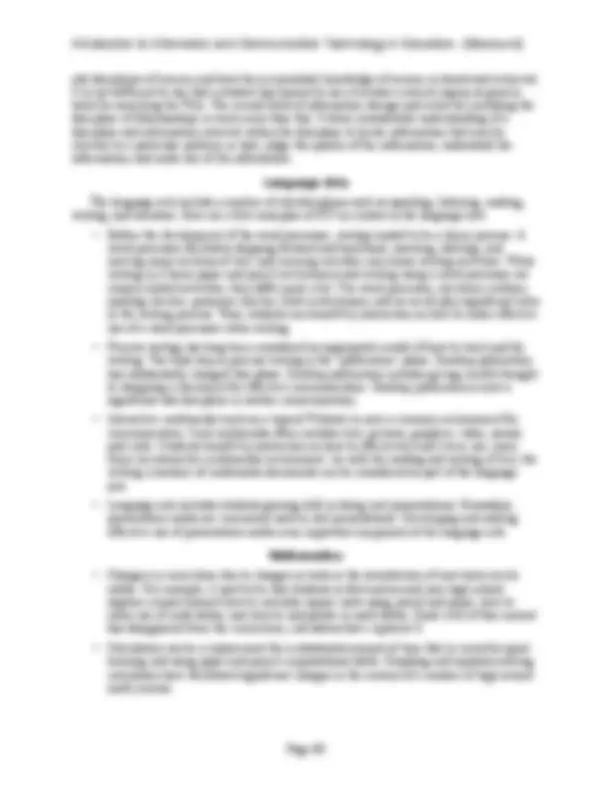
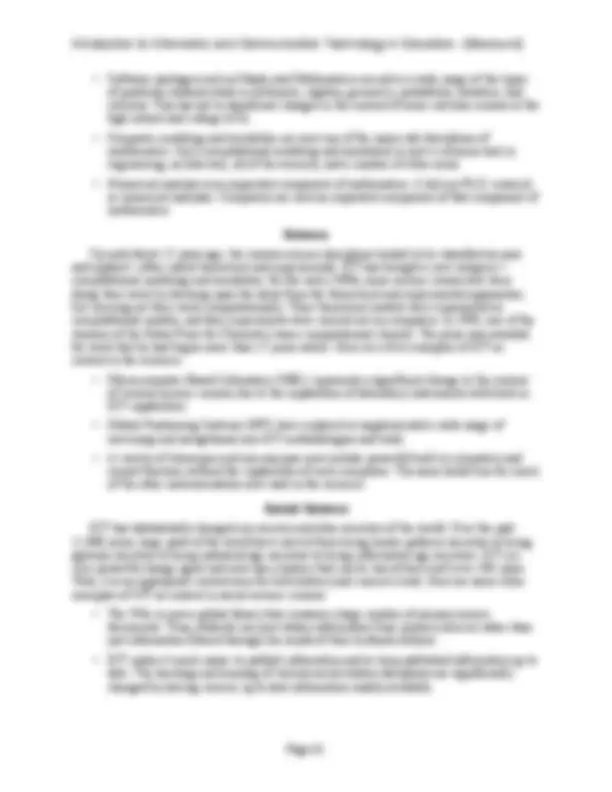



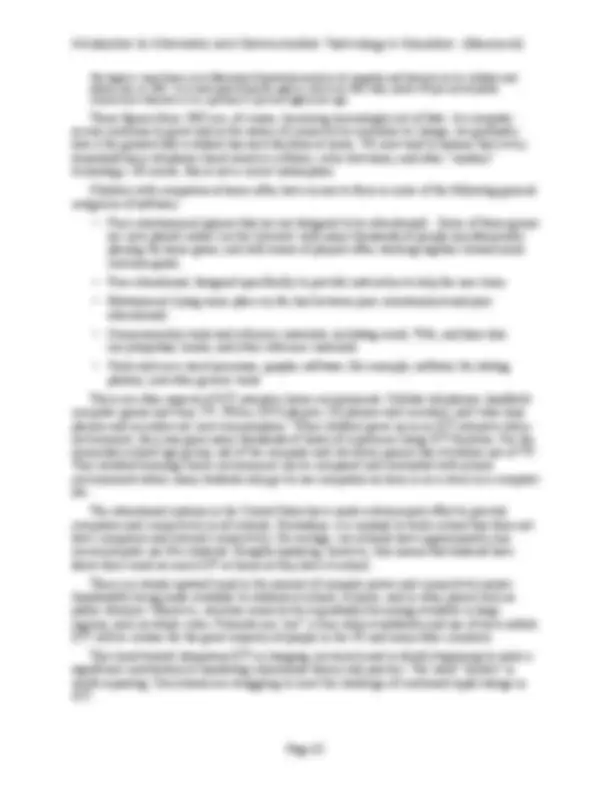
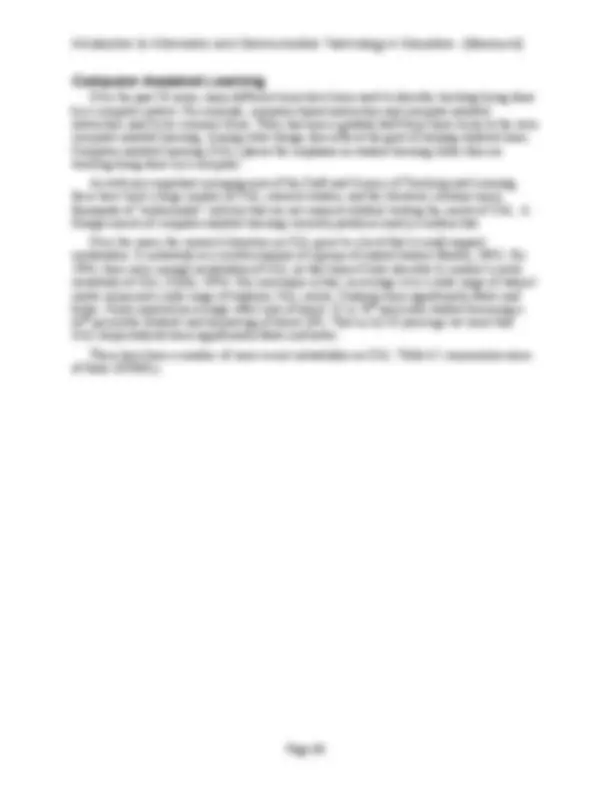




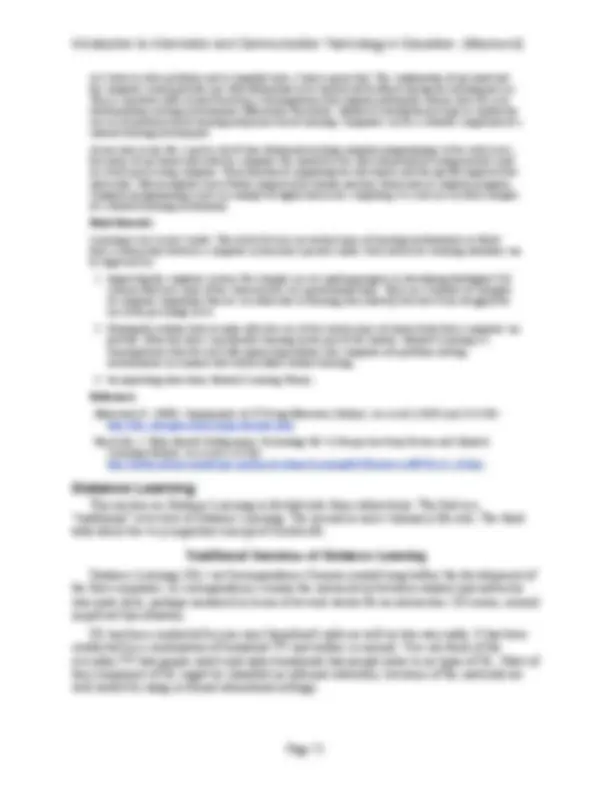















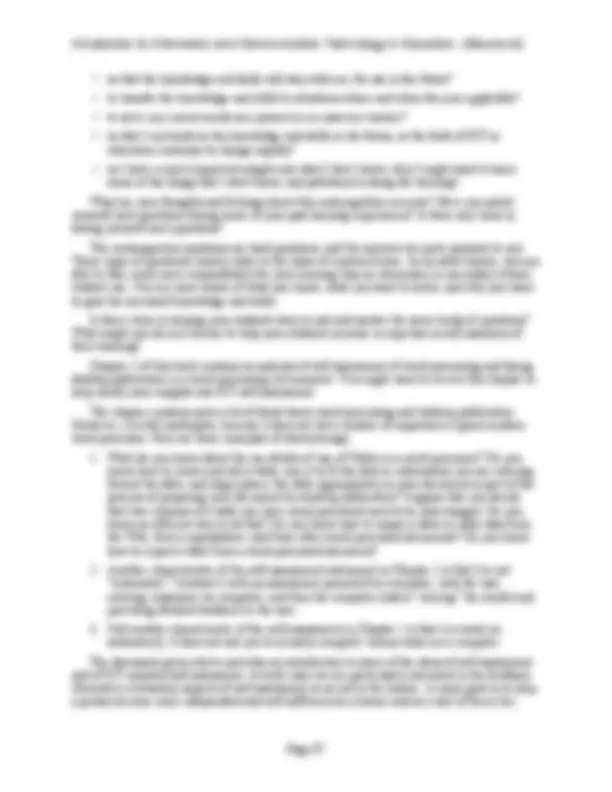
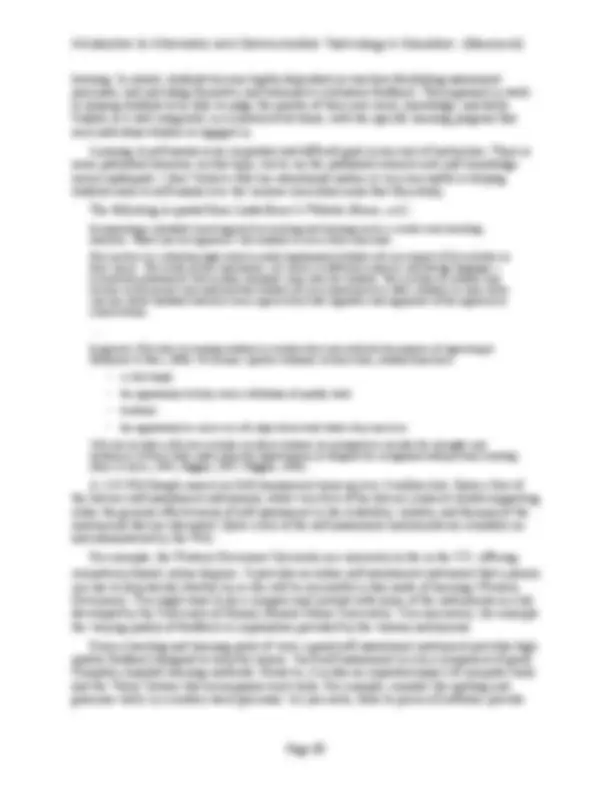


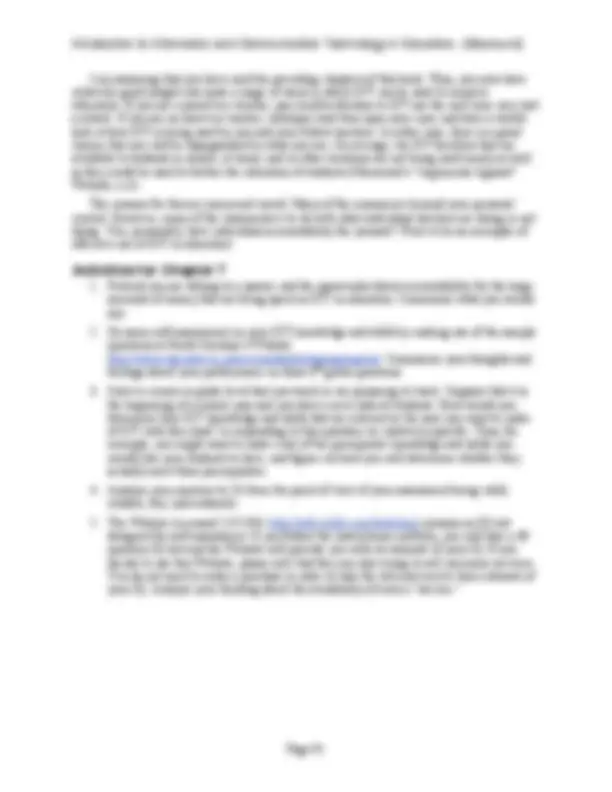
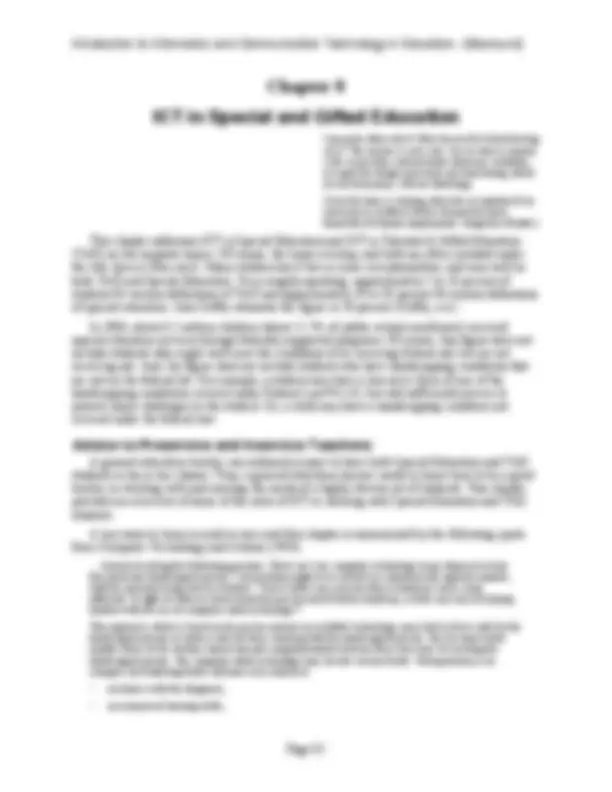


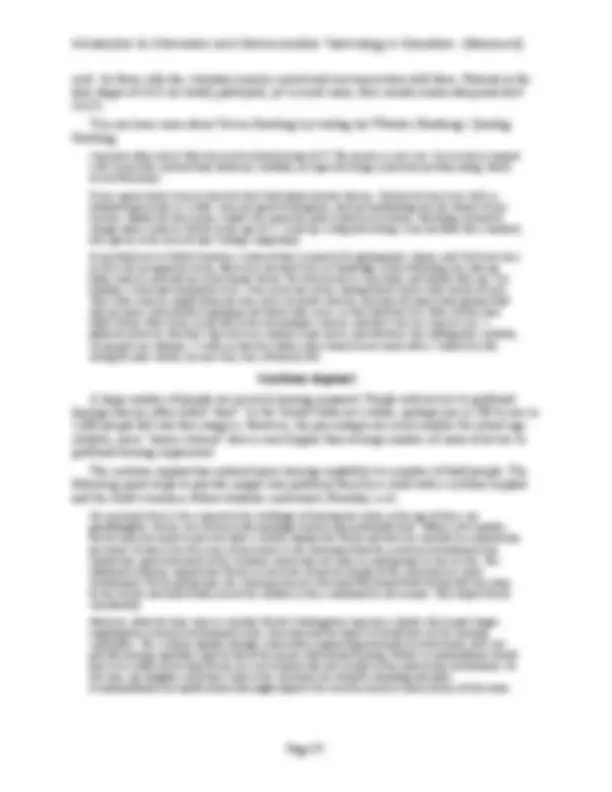


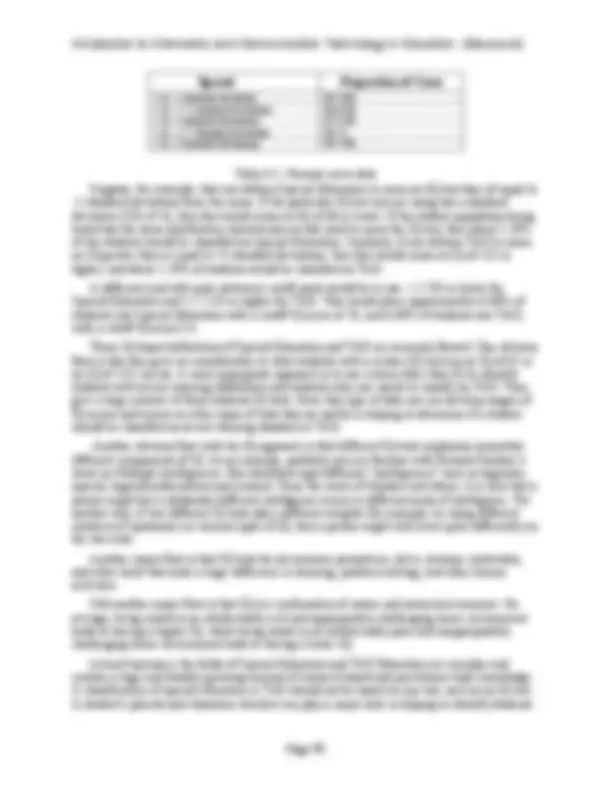
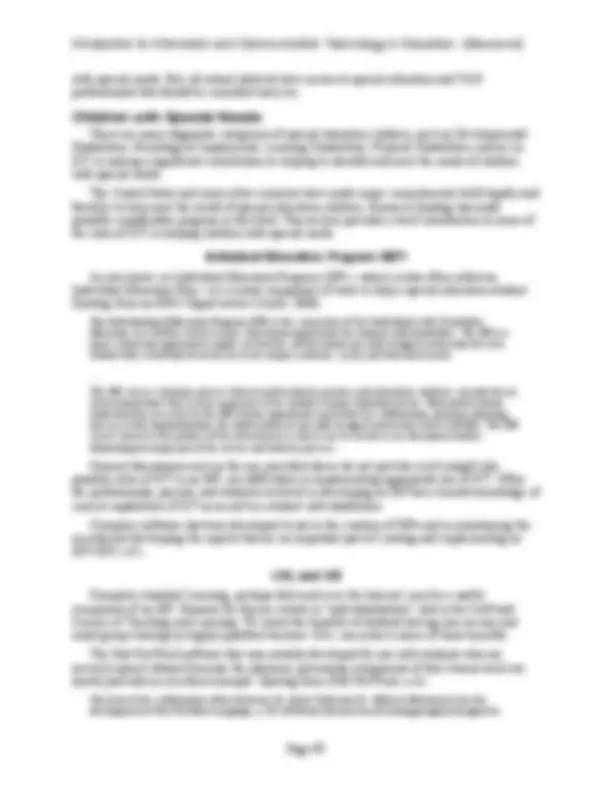



Study with the several resources on Docsity

Earn points by helping other students or get them with a premium plan


Prepare for your exams
Study with the several resources on Docsity

Earn points to download
Earn points by helping other students or get them with a premium plan
Community
Ask the community for help and clear up your study doubts
Discover the best universities in your country according to Docsity users
Free resources
Download our free guides on studying techniques, anxiety management strategies, and thesis advice from Docsity tutors
Introductionto Information and Communication Technologies
Typology: Lecture notes
1 / 121

This page cannot be seen from the preview
Don't miss anything!





























































































"Smooth seas do not make skillful sailors." (African Proverb) "You can lead a horse to water, but you can't make it drink." (A familiar adage.)
use of these materials for non^ These materials are Copyright (c) 2005 by-commercial, non^ David Moursund. Permission is granted to make-profit educational purposes by schools, school districts, colleges, universities, and other non teacher education organizations and activities.-profit and for-profit preservice and inservice
1/1/ David Moursund Teacher Education, University of Oregon Eugene, Oregon 97405 moursund@oregon.uoregon.edu
Preface ................................................................................ 2
"Without a struggle, there can be no progress." (Frederick Douglass, 1819-1895) "Men occasionally stumble over the truth, but most of them pick themselves up and hurry off as if nothing ever happened." (Sir Winston Churchill)
system. This book is designed^ Information and Communication Technology (ICT) is a major challenge to our educational for use by PreK-12 preservice and inservice teachers, and by teachers of these teachers. It provides a brief overview of some of the key topics in the field of Information and Communication Technology (ICT) in education. I wrote this book to help serve th access a syllabus for that course ate needs of my students in a course titled Teaching and Learning in the Digital Age. You can http://darkwing.uoregon.edu/~moursund/DigitalAge1/index.htm. pronged, research^ The mission of this book-based approach is used.^ is to help improve the education of PreK-12 students. A three- Goal # 1 substantial research that supports the contention that students get a better education when of this book is to help you increase your expertise as a teacher. There is they have “better” teachers. Goal # 2 roles of ICT in curriculum content, instruction, an of this book is to help increase your knowledge and understanding of variousd assessment. There is significant research to support the benefits of ICT in these three areas. In addition, ICT is now an important content area in each of the disciplines that you teach or are preparing to teach. Goal # 3 problem- (^) solving knowledge and skills. Special attention is paid to roles of ICT as an aidof this book is to help you increase your higher-order, critical thinking, to solving complex problems and accomplishing complex tasks in all curriculum areas. Research suggests that US schools are not nearly as strong as they could be in helping students gain increased expertise in problem solving and critical thinking.
designed to help you learn specific^ Now that I have stated goals for this book, I want to make clear a non pieces of software. The typical first ICT in Education-goal.^ This book is not course for preservice and inservice teachers has a strong focus on learning to make use of various pieces of hardware, software, and connectivity. This book is not designed as a substitute for, or a m before they get to college.ajor aid to, learning these rudiments of ICT that are now being learned by many students
education courses that overemphasize learning^ This book is designed to addresses some of the weaknesses of typical first or second ICT in computer applications and underemphasize other aspects of the field of ICT in education. The book focuses on general topics such as ICT in curriculum, instruction, assessment, increasing problem-solving expertise of students, and in other aspects of a teac skills. her’s professional work. The emphasis is on higher-order knowledge and
inservice teachers, building on the “basic skills” taught in a first course. However,^ Alternatively, this book can be used in a second ICT in education course for preservice and throughout the
"Mankind owes to the child the best it has to (United Nations Declaration of the Rights of the give." Child, 1959) "Civilization advances by extending the number of important operations which we can perform without thinking of them." (Alfred North Whitehead)
and/or because you are interested in learning more about how computers can contribute to^ It is assumed that you are reading this book because you are a preservice or inservice teacher, improving our educational system. Relatively few people thoroughly read an entire textbook. Their enthusiasm, interest, and energy level tends to wane as the book drags on and on. Thus, they often don’t reach the last chapter, which might be the most vital.
Second, I have^ To address this problem, I have done two things. First, I have kept this book relatively short. placed a large chunk of my intended last chapter at the beginning. Since it comes before the ordinary first chapter, I have numbered it Chapter 0. Chapter 0 contains a brief introduction to and summary of the Big Ideas (the unifying, very important themes) covered in this book. (and if) you reach the end of this book, please come back and read Chapter 0 again. You may be^ I hope that your reading of this chapter will lead you into reading subsequent chapters. When pleasantly surprised by how much you have learned! technology. It includes the full range of computer hardware and software, telecommunication^ The field of Information and Communication Technology (ICT) combines science and and cell phones, the Internet and Web, wired and wireless networks, digital cameras, robotics, and so on. It includes the field of Computer and Information Science and a still and video huge and rapidly growing knowledge base that is being developed by practitioners and researchers. ICT has proven to be a valuable aid to solving problems and accomplishing tasks in business, industry, government, education, and many other human endeavors. This remainder of this chapter lists a few of the Big Ideas (the important, long-lasting, unifying ideas) that have guided the development of the material in this book.
that properly educated people, using tools that aid their physic^ The diagram of Figure 0.1 illustrates the single most important idea in this book. The idea isal bodies and their minds, can solve a wide variety of challenging problems and accomplish a wide variety of challenging tasks. In approaching these problems and tasks, sometimes people work in multi-person teams and sometimes they work in one knowledge and tools of the human race, assist even a one-person “teams.” Many other people, through the collective-person team.
Tools to extend mental capabilities. Tools to extend physical capabilities.
Formal and informal education and training to build mental and physical capabilities and one!s knowledge and skills to effectively use mental and physical tools individually and as a team member.
Task-Accomplishing^ Problem-Solving, Team
Figure 0.1. Problem-solving, task-accomplishing team. accomplish a task. The top part of the diagram focuses on the idea that throughout human^ The center of the diagram is a person or group of people working to solve a problem^ or history, humans have been developing tools to enhance the capabilities and performance of their bodies and minds. Think about:
education system. Up to that time, the body and mind tools could be learned throu^ Reading, writing, and arithmetic were the first tools that required a formal and protractedgh informal education and apprentice systems. After that time, we began to have formal schools that have many of the characteristics of today’s schools. The past 5,000 years have seen a huge growth in the number of students receiving formal education and the length of that formal education. many of these have been widely adopted. In terms of the diagram of Figure 0.1, this means that^ Also during the past 5,000 years, many new body and mind tools have been developed, and our informal and formal educational s order to appropriately accommodate the changing tools.ystem has been faced by the need for continual change in
aspect of problem solving^ A library can be thought of as being a mind tool. It facilitates the single most important—building on the previous work of others (Moursund, 2004a). The Web is a global library that is steadily growing in the depth and breadth of its contents. Communication over distance and time is an essential component of building on the work of other people. Thus, the Internet (which education. includes the Web) is of steadily growing importance in
partially automating mind and body tasks. Automated factory tools are, or course, an obvious^ Over a period of thousands of years, there has been steady progress in “automating” or example of this progress. But, consider the development of inexpensive paper and writing
attempts to improve our educational system. He analyzes the of how well they have contributed to accomplishing the following three basic and enduring goalsse attempted improvements in terms of education (Perkins, 1992, p5):
skills^ These three general goals—help guide formal educational systems throughout the world. They are widely accepted—acquisition^ & retention, understanding, and use of knowledge & goals that have endured over the years. They provide a solid starting point for the analysis of any existing or proposed educational system. We want students to have a great deal of learning and active use experience—both in school and outside of school—in each of these three goal areas.
of the reasons these goals have endured over the years is that they are flexible enough so that^ You will notice that these three general goals do not point to any specific content areas. One over time, people can make changes in curriculum content, instructional processes, assessment, teacher education, and so on. ICT is a powerful change agent in all of these aspects of our formal educational system. This book explores ICT from the point of view of the three goals stated by Perkins. It looks at ICT in terms of possible changes in curriculum content, instructional processes, assessment, teacher education, and so on. combination of information storage and retrieval, and in the automation of tasks that that can be^ Perkins’ first goal focuses on acquisition and retention. One of the strengths of ICT lies in a built on this type of accumul when it comes to quickly committing large amount of material “to memory” and retaining thisated knowledge. ICT systems are much more capable than people memorized material perfectly over a long period of time.
for you or some other human to understand something? In what sense does a computer system^ Perkins’ second goal focuses on understanding. What is your understanding of what it means “understand” something? As a preservice or inservice teacher, it is very important that you have clear insight into the similarities and differences between human understanding and ICT system understanding. In what ways do these two types of understanding complement each other? higher^ Pay special attention to the third goal. There, the emphasis is on problem solving and other-order knowledge and skill activities. You know that ICT systems can solve or help solve a wide variety of problems. How does a computer’s higher skills compare with a human’s higher-order and problem--solving knowledorder, problem-solving knowledge andge and skills? In what ways do these two types of problem complement each other or compete with each other?-solving and other higher-order knowledge and skills
higher^ The diagram in Figure 0.2 represents Perkins’ three goals of education from a lower-order point of view. This representation of the three goals is intended to suggest that-order to acquisition, retention, and understanding are all oriented toward being able to make effective use of what one is learning.
Acquisition and Retention
Understanding Use to Solve Problems & Accomplish Tasks
Higher-order
Bloom’s taxonomy^ Figure 0.2. Scale: lower provides another approach to analyzing lower-order to higher-order goals of education.-order versus higher-order knowledge and skills. Bloom’s 1956 scale (not an equal interval scale) uses the labels knowledge, comprehension, application, analysis, synthesis, and evaluation to define a continuum moving from lower (comprehension and application) Bloom stresses that the student is expected to have-order to higher-order. At the second and third levels understanding that allows tra not encountered before. nsfer to solving problems and accomplishing tasks that he or she has Note: Although this book contains a large number of citations and references, you can see that I did not provide one for Bloom’s Taxonomy. When I recently did a Google search on Bloom’s Taxonomy, I got about 48,000 hits. This reassures me that anyone who needs to read more about this important topic will be able to find appropriate reading material without my help. It also suggests a significant change that is going on in the “scholarly” world. Nowadays, I do much of my reading and other scholarly work sitting in front of (or, holding) a computer that is connected to the Internet. As I read, I often pause to check something out on the Web. I certainly hope that you ( students to develop such habits. my readers) are developing similar habits of mind and will help your
learner’s point of view is represented in the diagram of Figure 0.3.^ There are other ways to define lower-order and higher-order knowledge and skills. A
Novice Current Level of Expertise of Learner World Class
Lower-order Higher-order
The diagram of Figure 0.3 stresses that a student does not understand lower^ Figure 0.3. A student’s view of lower-order and higher-order.-order and higher- order as separate ideas. Rather, the student combines his or her lower knowledge and skills to perform at a certain level of expertise within a domain. From this point-order and higher-order
high knowledge and skill that is efficiently and effectively a accomplishing the tasks of the domain. Here are a few things to be aware of:pplied to solving the problems and
Generally speaking, it takes practice to maintain a certain level of knowledge and skill. At some^ After a person achieves a certain level of expertise, this level is not automatically retained. stage in decrease one’s capabilities. Finally, over time the top end of the expertise scale tends to move to one’s physical and mental development, an aging body and/or aging mind tend to the right. to maintain his or her current levels of knowledge and skills. Then imagine major progress in the^ As an example, consider a fully competent doctor whose medical practice work is sufficient field of medicine based upon development of new technologies and treatment methodologies. These developments “raise the bar”—in effect, they increase the level of expertise the doctor needs to be as good as he or she was.
are very important components of expertise in many areas, including tea^ This medical doctor story is applicable to teachers. ICT knowledge, skills, and effective useching. A teacher who is not gaining appropriate and increasing ICT knowledge and skills and incorporating this into curriculum, instruction, and assessment is actually decreasing in a very important component of his or her level of expertise as a teacher.
environments. This knowledge is called the Craft and Science of Teaching and Learning^ We now have 5,000 years of accumulated knowledge about teaching and learning in school.
teaching and learning. As an example, consider the idea of teaching and learning in a manner that^ Teachers and researchers have accumulated a huge amount of information about effective facilitates both retention and transfer to prob past two decades have witnessed the development of a lowlems and tasks one will encounter in the future. The-road, high-road theory of transfer. This theory helps us to design curriculum content and ins accomplishment of the three educational goals listed by Perkins.tructional processes that improve our
superseded by a variety of cognitive learn^ The stimulus-response theory of B.F. Skinnering theories. An understanding of early childhood^ has been supplemented and to a great extent development and learning has led to Head Start chemicals has led to the addition of folic acid and other vitamins in a variety of our foods, and programs. An understanding of vitamins and to removal of lead paint and leaded gas from our environment. We have a growing understanding of the effects of class size and the value of tutoring or very small group instruction.
indicates that some level of dyslexia may affect as many as one^ As another example, considering helping dyslexic students^ learn to read. Shaywitz-fifth of all students. Thus, as a^ (2003, p6) regular classroom teacher you are very apt to have one or more students with some degre dyslexia. Brain science researchers have identified differences in brain “wiring” betweene of students who readily gain fluency brain imaging equipment used by the brain res (speed and accuracy) in reading, and those who don’t. Theearchers is dependent on powerful computers as well as other technology. methods to help dyslexic students to learn to read well. Some of their^ Reading specialists and brain scientists^ are now working together to develop effective successful approaches make use of highly interactive computer is delivered over a telecommunications system, such as the Internet. In addition, dyslexic-assisted learning. Often this computer-assisted learning students benefit greatly from learning to use doing the writing on tests) and being given more time to take tests. a word processor to do their writing (including
successful in the wide scale implementation of our^ In summary, we know lots of ways to improve education. However, we are not particularly steadily growing understanding of the Craft and Science of Teaching and Learning. ICT provides us with tools that can help substantially in this endeavor.
A huge amount of learning occurs in the informal educational environment provided by the^ A baby or toddler is naturally inquisitive, intrinsically motivated, and an omnivorous learner. caregivers. We know that the quality of this environment makes a huge difference (on average) in the learning and cognitive growth of young children. Thus, many children reaching the kindergarten age are a year or more behind the “average” while many others are a year or more ahead. Head Start programs have shown that it is possible to significantly improve the situation for the laggards. increasing level of expertise as independent, self^ One of the goals of our formal educational system is to help each student develop an-responsible, self-sufficient, intrinsically motivated learner. Educational researchers know quite a knowledge provides us with some insights into how well our formal educational system is doing bit about adult learners, and this in helping students learn to learn and learn to take responsibility for their own learning. We know that there are very large variations in our level of success in meeting goals of students becoming increasingly responsible for their own learning.
increasing your knowledge, understanding, and effective use of ICT in education. As a^ The mission of this book is to help you improve the education of your students through preservice or inservice teacher, you know improving education. Quite likely you do not know about the broad range of possible uses of that ICT has been highly touted as a vehicle for ICT in education and the research (or, lack there of) that suggests these uses will improve education
distributed. That is, in some sense it is possible to apply ideas of automation to certain aspects of^ There are certain aspects of improving education that can be mass-produced and/or mass improving education. For example, we can work at a national level to develop be content and books that are designed to help students learn this curriculum content. Largetter curriculum numbers of such books can be printed and made available to large numbers of students. Similarly videos can be developed that combine curriculum content with some of our ideas on what constitutes effective instruction. Such videos can be distributed by broadcast and other methods in a manner that reach large numbers of students.
students. Good (human) teachers cannot be mass produced and/or mass distributed. As a^ However, good teaching by humans currently lies at the very heart of good education for preservice or inservice teacher, you have a responsibility of becoming as good a teacher as you can be. Moving up the “good teacher” expertise scale is a lifelong activity. The progress that you make will contribute to improving the education of your students. Activities for Chapter 0 reflective consideration of the chapter^ The activities here and at the end of other chapters are mainly designed to guide you in. They are an integral component of the content of the chapter. Spend a few minutes thinking about the questions assignments. Remember, education should not be a battle between students and their teachers.—even if they are not required You are an adult, and you should be able to take responsibility for your own learning.
"They know enough who know how to learn." (Henry Adams) "A great teacher makes hard Waldo Emerson) things easy." (Ralph
two key, unifying ideas:^ This book is about Information and Communication Technology^ (ICT) in education. Here are
that properly educated people, using tools that aid their physical bodies and their minds, c^ The diagram of Figure 1.1 illustrates the single most important idea in this book. The idea isan solve a wide variety of challenging problems and accomplish a wide variety of challenging tasks. Such tools empower us to do things we cannot do without the tools.
Tools to extend mental capabilities. Tools to extend physical capabilities.
Formal and informal education and training to build mental and physical capabilities and one!s knowledge and skills to effectively use mental and physical tools individually and as a team member.
Task-Accomplishing^ Problem-Solving, Team
Figure 1.1. Problem-solving, task-accomplishing team. arithmetic and mathematics, and ICT. And, of course, you know that ICT plays a major role in^ Some examples of mental tools (often called mind tools) include reading and writing,
are being affected by the developments that are occurring in ICT. Thus we are led to four specific ICT in education questions:
answers to the questions are changing and will continue to change in the future.^ These are hard questions. Moreover, ICT continues to change at a very rapid pace. Thus, system. It is a major c^ This issues raised in these questions are a challenge to our PreKhallenge to both preservice and inservice teachers. The rapid pace of-12 and teacher education change in ICT is continually outdating their ICT knowledge and skills.
envir^ We now have 5,000 years of accumulated knowledge about teaching and learning in schoolonments. This knowledge is called the Craft and Science of Teaching and Learning. Part of the progress in the Craft and Science of Teaching and Learning falls into the area called Brain and Mind Science. The remainder of this section gives a brief introduction to that field. Chapter 0 provides one example of such progress in its discussion of dyslexia. The next major section of the current chapter contains more information about the Science of Teaching and Learning.
of the brain^ Continuing research on the science of the mind (neuroscience), and rapid continuing progres^ (psychologys in ICT are making significant), recent research on the science contributions to the field of problem solving in all disciplines. The following three sub sections contain three Big Ideas emerging from this progress.
Brain Versus Computer Even now, more than 50 years later, many people still use this term. Certainly a human brain and^ In the early days of computers, people often referred to such machines as^ electronic brains. a computer have some characteristics in common. However:
Big Idea # 1: there are many things that human brains can do much better than computers. Our educational There are many things that computers can do much better than human brains, and system can be significantly improved by building on the relative strengths of brains and computers, and decreasing the emphasis on attempting to “train” students to compete with computers. We need to increase the focus on students learning to solve problems using the strengths of their brains and the strengths of ICT.
Chunks and Chunking Here are three different types of human memory:
memory is about 7^ Research on short ± 2 chunks-term (“working”) memory indicat. This means, for example, that a typical person can read or hear aes that for most people the size of this seven When I wa-digit telephone number and remember it long enough to key into a telephone keypad.s a child, my home phone number was the first two letters of the word diamond, followed by five digits. Thus, to remember the number (which I still do, to this day) I needed to remember only six chunks. But, I had to be able to decipher the first chunk, the word “diamond.”
Input to computer memory can be very rapid (for example, the equivalent of an entire book in a^ Long-term memory has a very large capacity, but this does not work like computer memory. second), and can store such data letter perfect for a memorize large amount of poetry or other text. But, this is a long and slow process for most long period of time. The human brain can people. By dint of hard and sustained effort, an ordinary person can memorize nearly letter perfect the equivalent of a few books. However, the typical person is not very good at this. At the current time, the Web contains the equivalent of many millions of books.
information. Think^ On the other hand, the human brain is very good at learning meaningful chunks of about the chunks such as constructivism, multiplication, democracy, transfer of learning, and Mozart. Undoubtedly these chunks have different meanings to me than they do for you. As an example, for me, the chunk “multiplication” covers multiplication of positive and negative integers, fractions, decimal fractions, irrational numbers, complex numbers, functions (such as trigonometric and polynomial), matrices, and so on. My breadth and depth of meaning and understanding was developed through years of undergr mathematics. aduate and graduate work in
image, sound, smell, taste, or touch) and a pointer or index term that does two things:^ It is useful to think of a chunk as a label or representation (perhaps a word, phrase, visual
Constructivist curricula often emphasize group ac collaborative skills of the sort that are often required within contemporary work environments. Such grouptivities designed in part to facilitate the acquisition of activities may offer students of varying ages and ability levels, and having different int experience, the opportunity to teach each other -- a mode of interaction that has been found to offererests and prior significant benefits to both tutor and tutee. Explicit attention is also given to the cultivation of higher thinking skills, including "meta-level" learning -- the acquisition of knowledge about how to learn, and how-order to recognize and "debug" faulty mental models. PBL and the above discussion o^ Those of you who are familiar with projectf constructivism. At the current time, this book does not contain-based learning will see a strong parallel between a chapter on ICT PBL Website, n.d.). That Website contains a detailed syllabus for a one-Assisted PBL. In lieu of this, I maintain a Website on that topic (Moursund,-credit course on ICT- Ass bibliography. I strongly recommend that instruction on this topic be included in the same courseisted PBL, most of the reading material needed for such a course, and a large annotated where the book you are currently reading is being used. Situated Learning
focuses on the idea that much of what we learn is dependent on the specific situation^ A learning theory called Situated Learning has been developing over the past two decades. It (environment, context) in which the learning oc doing and learning by addressing real, challenging problems.curs. Situated Learning emphasizes learning by
Situated Learning and ICT work well together. Situated Learni^ ICT is a powerful aid to "doing" and to "addressing real, challenging problems." Thus,ng and Constructivism are compatible and mutually supportive.
theories (Kearsley, n.d.). Quoting Kearsley:^ Greg Kearsley maintains a Website that discusses a large number of different learning [Jean] Lave argues that learning as it normally occurs is a fun which it occurs (i.e., it is situated). This contrasts with most classroom learning activities which involvection of the activity, context and culture in knowledge which is abstract and out of context. Social interaction is a critical component of situate learning -- learners become involved in a "community of practice" which embodies certain beliefs andd behaviors to be acquired. As the beginner or newcomer moves from the periphery of this community to its center, they become more active and engaged within the culture and hence assume the role of expert or old- timer. Furthermore, situated learning is usually unintentional rather than deliberate. These ideas are what Lave & Wenger (1991) call the process of "legitimate peripheral participation."
routinely make use of computers (email and the Web), cell telephones, CD and DVD players,^ Nowadays,^ the majority of adults in the United States (and, in many other countries) and a large number of ICT systems that are built into cars, TV sets, and so on. By the end 1999, the number of computers being used in the “white collar” sector of business and industry of in the US exceeded the number of workers in this sector. That is, the ratio of computers to workers exceeded 1.0.
US have an average of about one microcomputer per four to five students. Although more than^ This situation is in stark contrast with student use of ICT in PreK-12 schools. Schools in the half of these microcomputers are now located in classrooms (as contrasted with computer labs), their use is not routinely integrated into everyday student work. A significant fraction of the available ICT resources are used for playing games or using edutainment software that has questionable educational value. It is common for students in elementary schools to be scheduled into a computer lab for about 40 the work done there is often not integrated with their routine classroom work. Viewed from a-50 minutes, one or twice a week. The instruction in the lab and Situated Learning perspective, the general types of uses of ICT in school are relatively far
removed from the general goals for our educational system as well as from the goals for ICT in education that have been set by many states and by the International Society for Technology in Education (ISTE NETS, n.d.). Motivation
(internally) motivated to learn. If the child is provided with an environment that is^ A newborn child’s^ brain is designed to learn, is naturally curious, and is intrinsically reasonably conducive to and supportive of learning, learning will occur at a rapid pace. This learning will include the marvelous accomplishment of learning to speak and to understand speech, and learning the culture of his or her environment. A child rais environment will become fluent in two languages and will become bicultural. This speaks to aed in a bilingual, bicultural child’s learning potential, and to the fact that our informal and formal educational system is not doing well in helping children achieve their learning potentials.
system of rewards and/or punishments. Likely you are familiar with B.F. Skinner’s^ You are familiar with many different forms of extrinsic motivation, perhaps based on a theory of behaviorism other animals can be trained to elicit certain predefined behaviors. These stimulus/response types. Through appropriate use of behaviorist principles, rats, cats, dogs, people, and of training behavioral learning theory has largely given way to a variety of cognitive learning theories. have proven to be quite effective. Note, however, in terms of education of humans,
consider a child growing up in the environment/culture of the home and community that includes^ There is no fine dividing line between intrinsic and extrinsic motivation. For example, the routine playing of musical instruments and enjoyment of music. Howard Gardner lists musical intelligence as one of the eight innate intelligences that people have (Gardner, n.d.). One can argue that each person has a certain level of intrinsic motivation to learn and do music. Growing up in a musically rich environment/culture provides a type of extrinsic motivation that blends with a child’s intrinsic music motivation. Eventually the child may develop a high level of intrinsic motivation in the field of music, and he or she may pursue a professional career in this field.
students to become intrinsically motivated. Students who are intrinsically motivated (inherently^ The music example illustrates a key idea in education. Teachers face the task of helping their interested) in a particular learning task will tend to learn more, better, faster, and remember longer what they have learned. Contrast this with a student who is extrinsically motivated to pass an upcoming test. The motivation may be to avoid failing a course, to get a good grade in a course, to please the teacher or parents, to get a money reward from parents, and so on. By and large this extrinsic type of motivation leads to a “memorize, regurgitate, and quickly forget of learning. ” type
grandchildren grow up in ICT^ During my lifetime, I had the pleasure of watching my children and s-rich home environments. For many children, interactive computerome of my games and other aspects of ICT are highly attention grabbing motivating. When given an appropriate supportive environment, many children become and seem be intrinsically intrinsically motivated to learn and routinely use ICT for play and work.
be intrinsically motivating. Perhaps the firs^ Over the years a number of “productivity” software tools have been that many people find tot example was the spreadsheet. Approximately a half million people acquired Apple 2e computers and this software because it fit so well with what they wanted to do. A number of other intrinsically motivating pieces of tool software are discussed in Moursund (2000).